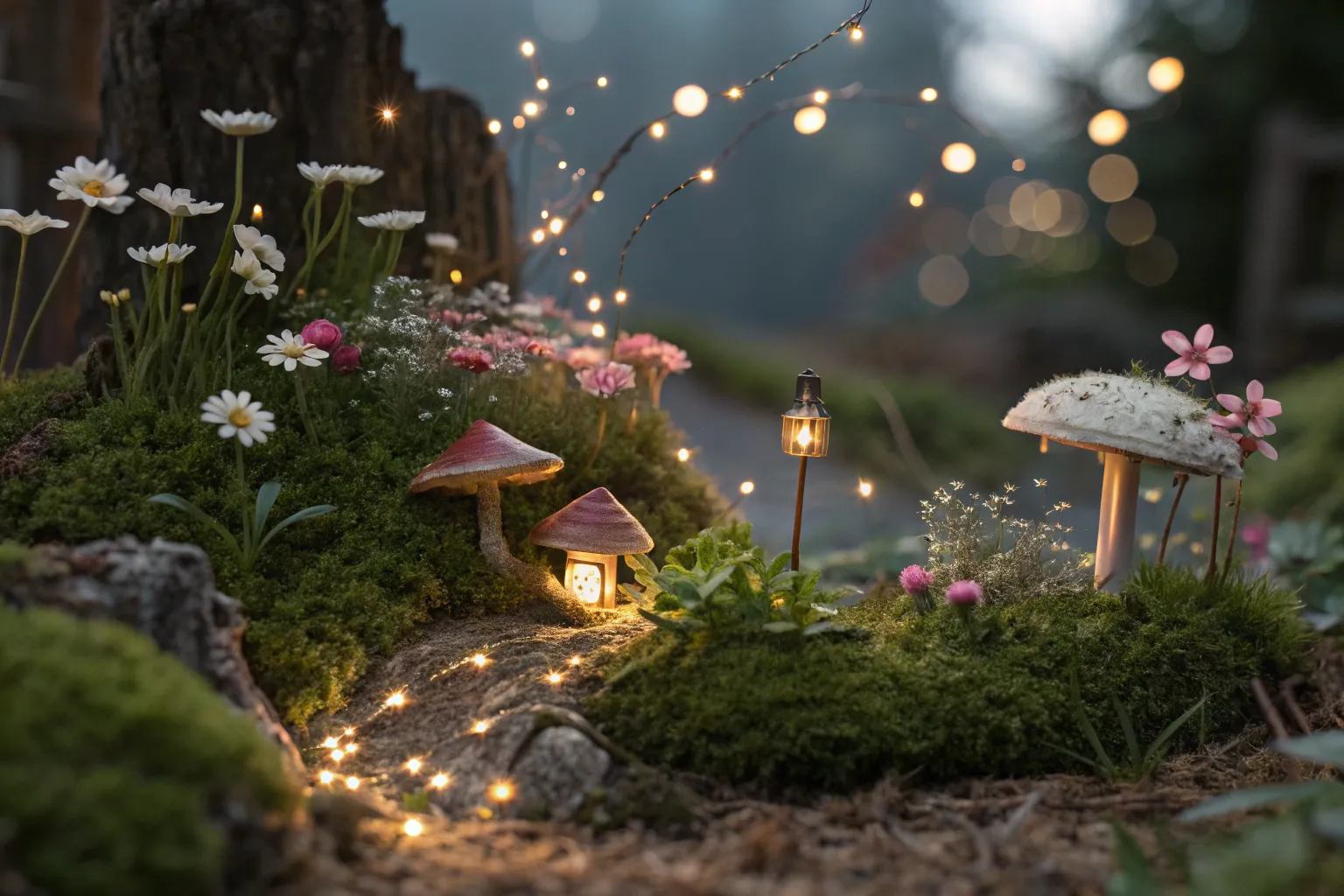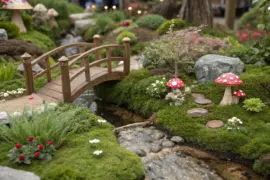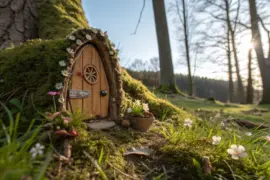Step into a miniature world where imagination takes root. Building a living fairy landscape isn’t about perfection—it’s about creating a small, enchanted space that invites wonder and tells a story only you can craft.
Gathering Your Foundation

Before you dive into construction, think about where your fairy world will live. A wide, shallow container works beautifully for beginners—terrariums, wooden boxes, or even repurposed planters give you control over your landscape while keeping maintenance simple. For outdoor gardens, choose a sheltered spot near a tree base or tucked into a garden corner where moss naturally wants to grow.
Your base layer matters more than you might expect. Start with drainage rocks at the bottom, add a thin sprinkle of activated charcoal to keep things fresh, then layer in quality potting soil mixed with a handful of moss. This foundation supports everything above it, creating the right moisture balance for living plants while giving you a stable canvas for building.
Think of natural materials as your primary building blocks. Twigs become fence posts and ladder rungs. Flat stones transform into pathways. Bark pieces turn into roofing shingles. Moss—the hero of any fairy landscape—carpets the ground in living green. I find that combining these foraged materials with simple craft supplies like popsicle sticks and air-dry clay gives you endless creative freedom without requiring advanced skills.
Building the Scene

Creating Homes and Structures
Your fairy dwellings set the tone for the entire landscape. For a rustic, woodland feel, construct simple houses from twigs glued together in log-cabin style, topped with bark shingle roofs. Cut Styrofoam or use small boxes as your base structure, then cover every surface with your natural materials using silicone sealant for outdoor durability or hot glue for indoor projects.
Popsicle stick houses offer another beginner-friendly option, especially when crafting with children. Glue the sticks into rectangular walls, add a peaked roof, and paint or stain them in earthy tones. Small doors can be crafted from additional sticks or bark pieces, with a tiny pebble or bead serving as a charming doorknob.
For something more whimsical, shape air-dry clay around recycled containers like yogurt cups or plastic bottles to create mushroom houses or fairy cottages. Let the clay dry completely, then paint with acrylics in soft, nature-inspired colors. These structures are lightweight and give you complete creative control over shape and detail.
Designing Pathways and Landscapes
Pathways guide the eye and create flow through your miniature world. Arrange small, flat pebbles in winding trails, or use fine gravel to suggest well-worn fairy roads. For texture variation, try thin slices of wood as stepping stones, or press small twigs into the soil to form rustic borders along your paths.
Working with scale and depth transforms a flat arrangement into a believable landscape. Place larger rocks and taller structures toward the front, gradually transitioning to smaller elements in the back. This forced perspective tricks the eye into seeing more distance than actually exists. Slope your soil from back to front, creating hills and valleys that add dimension.
Sheet moss works beautifully as living ground cover, while cushion moss adds textured “shrubs” in miniature scale. Tuck moss around rocks and structures, letting it soften hard edges and blend elements together naturally. The moss will continue growing in humid environments, gradually making your landscape look more established.
Furniture and Accessories
Simple accessories bring personality to your fairy spaces. Popsicle sticks become picnic tables, benches, and fences with just glue and basic cutting. For a tiny table, glue four short stick pieces as legs to a square made from four longer pieces. A miniature ladder forms from two parallel sticks connected by evenly spaced crossbars.
Natural materials offer even more possibilities. Acorn caps become tiny planters. Large seeds or small shells serve as fairy dishes. Champagne cork cages transform into French café chairs with their wire framework. Twist thin wire or twine into swings, arbors, or decorative garden elements.
You can sculpt miniature tools, vegetables, or mushrooms from polymer clay or air-dry clay. Roll small balls of clay for mushroom caps, attach them to thin twig stems, and paint them in classic red-and-white toadstool patterns. These handmade touches add storytelling details that make your landscape feel lived-in and loved.
Choosing Plants for Your Living Landscape

Living plants transform a static scene into a dynamic fairy garden that changes with the seasons. For beginners, select plants that share similar light and water needs, then group them accordingly.
Sun-Loving Options
If your landscape sits in bright light, consider miniature succulents—tiny echeveria, sedum, or jade plants stay compact and require minimal watering. Creeping thyme spreads into a fragrant purple-flowered carpet perfect for fairy meadows. Small varieties of dianthus, alyssum, and dwarf rosemary add color and texture without overwhelming your tiny world.
Shade-Tolerant Choices
For shadier spots or indoor settings, miniature ivy trails gracefully over edges and climbs tiny structures. Miniature ferns create delicate, woodland textures. Baby tears (Soleirolia) form a dense, moss-like ground cover that stays low and manageable. Moss itself thrives in indirect light and humidity, making it ideal for closed terrariums or shaded outdoor gardens.
Caring for Living Elements
Moss needs moisture but not sogginess—mist it with filtered or rainwater rather than drenching it. In closed terrariums, condensation recycles moisture naturally, so you’ll rarely need to water. Open containers require more frequent misting, especially in warm weather. Watch for yellowing or dullness as signs of dehydration, and give dried moss a good spray to revive it.
Trim plants as they grow to maintain proportion. Remove dead leaves and spent flowers regularly to keep your landscape tidy and prevent mold in humid environments.
Lighting for Atmosphere

Light brings magic to fairy landscapes, especially in evening hours. Battery-operated LED fairy lights tuck easily into miniature scenes without requiring outlets. Look for thin copper wire strings with tiny bulbs—these flexible strands weave through plants and around structures nearly invisibly during daylight, then create a warm, enchanted glow after dark.
Solar-powered options work beautifully for outdoor fairy gardens. Position the small solar panel in a sunny spot, then let the lights charge during the day and automatically illuminate at dusk. Warm white LEDs feel cozier and more magical than cool white, though you can experiment with color to create different moods.
For a subtle effect, hide lights behind structures or tuck them under moss to create soft ambient glowing rather than bright pinpoints. You can also position a single light inside a fairy house, shining through windows you’ve cut or left open, to suggest someone’s home.
Beings & Creatures

Fairy landscapes come alive with small inhabitants, though you have creative freedom in how much or how little you include. Simple polymer clay or air-dry clay figurines keep things kid-friendly and let you customize your characters.
Making Clay Creatures
Start with basic shapes for sweet woodland animals—roll clay into balls and ovals, then pinch and shape them into mice, hedgehogs, rabbits, or birds. You don’t need sculpting experience to create charming characters. Add tiny details with a toothpick: texture for fur, indentations for eyes, or lines for wings.
For creatures with a bit more magic, try simple snails with spiral shells, tiny frogs, or caterpillars made from connected clay balls. Gnomes are wonderfully beginner-friendly: form a cone for the body, add a round head, shape a pointed hat, and paint them in earthy tones with rosy cheeks.
Polymer clay needs baking according to package directions, while air-dry clay simply sits out for 24-48 hours until fully hardened. Once dry, paint your creatures with acrylics, adding personality through expression and color choices. Seal painted figures with a clear coat for protection, especially if they’ll live outdoors.
Nature-Inspired Characters
Some of the most enchanting fairy creatures come straight from your imagination combined with natural materials. Wrap clay around twigs to create tree spirits or forest guardians. Press dried leaves into soft clay to add fairy wings or decorative patterns before the clay hardens. Small pinecones become hedgehogs or owls with just a clay face and feet attached.
Keep characters proportional to your landscape. Figures around one to two inches tall work well for most fairy gardens, letting them interact believably with your houses and furniture while remaining visible.
Finishing With a Touch of Magic
Texture and Contrast
Successful fairy landscapes engage multiple senses through varied textures. Combine smooth river pebbles with rough bark, soft moss with spiky succulents, delicate flowers with chunky stones. This variety creates visual interest and makes your miniature world feel richer and more complex.
Don’t let everything be green. Introduce pops of color through flowers, painted doors, or small decorative elements like colored glass gems as fairy “jewels” scattered along paths. These bright moments catch the eye and add points of interest throughout your landscape.
Creating Focal Points
Every strong composition needs a focal point—the place where a viewer’s eye naturally lands first. In fairy landscapes, this might be your most detailed house, a particularly charming character, or a special feature like a tiny pond made from a mirror piece. Position your focal point slightly off-center following the rule of thirds, then arrange other elements to lead the eye toward it.
Use directional lines to guide attention. Pathways that curve toward your main house, plants that lean inward, or a ladder leading up to a doorway all create visual movement that tells viewers where to look.
Telling a Story
The most memorable fairy landscapes hint at narratives without spelling everything out. Scatter tiny clay vegetables near a garden plot with miniature tools nearby, suggesting harvest time. Place a small bench beside a “pond” as if someone just sat there watching the water. Hang laundry made from fabric scraps on a twine line, or position an open door with lights glowing inside as though the fairies just stepped out.
These storytelling details don’t need elaborate execution—simple suggestions spark imagination more effectively than overly finished scenes. Leave some things ambiguous, inviting viewers to wonder and create their own stories about who lives here and what they might be doing.
Seasonal Updates and Ongoing Care
Living fairy landscapes evolve naturally, but you can enhance seasonal changes with small updates. Tuck in tiny pumpkins or acorn “decorations” for autumn. Add a dusting of white sand or artificial snow around winter holidays. Plant miniature spring bulbs for early color, or switch out summer flowers as they fade.
Check your landscape weekly, removing any dead plant material, adjusting moisture levels, and ensuring structures remain secure. Outdoor gardens need more maintenance than indoor terrariums, especially after rain or wind. Indoor scenes benefit from occasional gentle cleaning with a soft brush to remove dust from moss and accessories.
As plants grow and spread, don’t hesitate to trim them back or relocate elements. Fairy landscapes aren’t meant to be static—they’re miniature ecosystems that change and develop character over time. Some of your most magical moments might come from unexpected moss patterns, self-seeded flowers, or the way light falls differently as seasons shift.
Beginning Your Own Fairy World
Start simple. Choose one or two core elements—perhaps a small house and a winding path—then build from there as confidence grows. Gather materials from your own backyard before purchasing anything, letting the shapes and textures you find inspire your design. Remember that the most enchanting fairy landscapes often come from the heart rather than from expensive supplies or perfect execution.
The real magic happens when you slow down enough to work at miniature scale, placing each tiny element with intention and care. Whether you’re creating alongside children or crafting your own peaceful retreat, building these small worlds offers a gentle reminder that beauty and wonder can flourish in the smallest spaces—you just have to know where to look.





